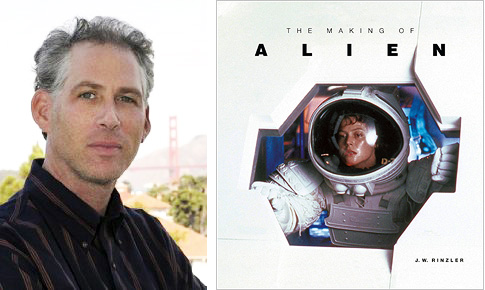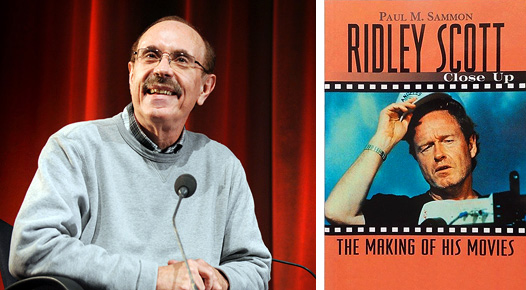The popular and influential film, which spawned several sequels and numerous imitations, opened forty years ago this month. For the occasion The Bits features a compilation of statistics and box-office data that places Alien’s performance in context, plus passages from vintage film reviews, a reference/historical listing of the movie’s opening-day presentations, and, finally, an interview segment with a trio of historians who reflect on the film four decades after its debut.
And, in case you missed them or desire a refresher, the Bits’ other Alien-themed retrospectives include Aliens 30th anniversary and Predator 30th anniversary.
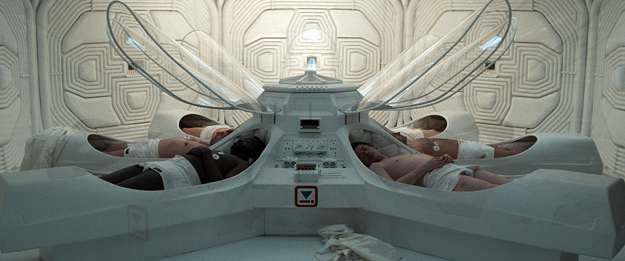
ALIEN NUMBER$
- 1 = Rank among top-earning films in the Alien franchise (adjusted for inflation)
- 1 = Number of Academy Awards
- 2 = Number of Academy Award nominations
- 2 = Rank among top-earning films directed by Ridley Scott (adjusted for inflation)
- 2 = Rank among top-earning films of 1979 (summer season)
- 2 = Rank among top-earning horror films of 1979
- 2 = Rank among top-earning R-rated films of 1979
- 2 = Rank among top-earning science-fiction films of 1979
- 3 = Number of Saturn Awards
- 4 = Rank among top-earning films of 1979 (calendar year)
- 6 = Rank among Fox’s all-time top-earning films at close of original run
- 6 = Rank among top-earning films of 1979 (retroactive / legacy / lifetime earnings)
- 7 = Number of sequels, prequels and spin-offs
- 7 = Rank on AFI’s list of best science fiction films
- 13 = Number of months between theatrical release and home video release
- 24 = Number of weeks of longest-running theatrical engagement
- 29 = Rank among top-earning movies of the 1970s (earnings from 1/1/70 - 12/31/80)
- 32 = Peak all-time box-office chart position
- 91 = Number of theaters playing the movie during opening week (91 venues, 94 screens)
- 110 = Number of 70mm prints during first-run (worldwide)
- 757 = Peak number of theaters simultaneously showing the movie (week of July 6-12)
- $1,000 = Approximate cost of each 35mm print
- $8,000 = Approximate cost of each 70mm print
- $38,767 = Opening weekend per-screen-average
- $2.0 million = Box-office gross of 2003 re-release
- $3.5 million = Opening weekend box-office gross (4-day holiday, May 25-28)
- $11.0 million = Production cost
- $24.0 million = Box-office gross (international)
- $38.7 million = Production cost (adjusted for inflation)
- $40.1 million = Box-office rental (% of gross paid to distributor)
- $49.0 million = Box-office rental (worldwide)
- $78.9 million = Box-office gross (original release)
- $80.9 million = Box-office gross (lifetime, includes re-releases)
- $84.5 million = Box-office gross (international, adjusted for inflation)
- $104.9 million = Cumulative box-office gross (worldwide)
- $141.1 million = Box-office rental (adjusted for inflation)
- $172.5 million = Box-office rental (worldwide, adjusted for inflation)
- $277.7 million = Box-office gross (original release, adjusted for inflation)
- $364.4 million = Cumulative box-office gross (worldwide, adjusted for inflation)
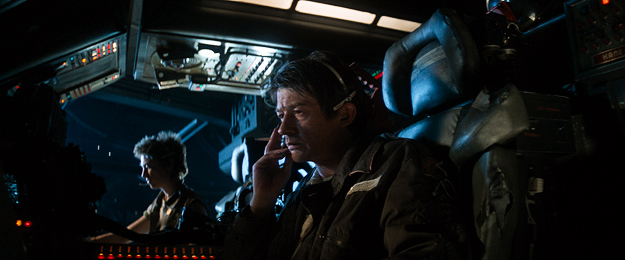
A SAMPLING OF PASSAGES FROM REVIEWS
“The horror genre, in any period, is one that you like, or leave distantly alone. The violence in Alien is less ’real’ than the shark-infested waters of Jaws. But telling yourself that these galactic goings-on are improbable nonsense is less effective than it should be in unclenching your fists or making your heart stop pounding. Surrender at all to Scott’s extraterrestrial make-believe and you are in for jolts, shocks and some fairly gruesome and shuddering sights.” — Charles Champlin, Los Angeles Times
“Don’t race to it expecting the wit of Star Wars or the metaphysical pretensions of 2001 and Close Encounters of the Third Kind. At its best it recalls The Thing [from Another World], though the Howard Hawks film was both more imaginatively and more economically dramatized.” — Vincent Canby, The New York Times
“Alien is a corker, a walloper, a rouser, a screecher and a ton of fun. If all movies were as thrilling I would happily spend all of my life in the movies.” — Gene Shalit, NBC-TV
“Alien is an expensively assembled science-fiction and horror shocker that’s being pushed hard by 20th Century Fox, and enough of it works on the gut-level of cheap thrills to justify the company’s high expectations. Alien has its problems [though]. Special effects and shock moments aside, Scott seems ponderous about getting through simple plot mechanics that one of the old science-fiction films could have tossed off with workmanlike abandon. But for those who like this kind of film, he’s produced — in 70mm and Dolby sound — something like the equivalent of every amusement park ride rolled into one.” — Walter V. Addiego, San Francisco Examiner
“[Alien] reached out, grabbed you, and squeezed your stomach it was more gripping than entertaining, but a lot of people didn’t mind. They thought it was terrific, because at least they’d felt something: they’d been brutalized.” — Pauline Kael, The New Yorker
“You’re going to be most appreciative of Alien in its most technically advantageous circumstances.” — Eric Gerber, The Houston Post
“I left Alien feeling contentedly manipulated, but not in an unparalleled entertaining panic. The monster’s one blood-spattered attack will probably become the most talked-about sequence in Alien. The climactic episodes are a rather more impressive cinematic achievement.” — Gary Arnold, The Washington Post
“Alien is mostly in the business of thrills, and on that level it did provide more than a few. I looked away from the screen during its most gory scenes. Even more enjoyable, though, was watching the film debut of an actress who should become a major star, Sigourney Weaver (she probably changed her name from Alice) makes an auspicious debut as one of the sturdiest crew members.” — Gene Siskel, Chicago Tribune
“Alien is an old-fashioned scary movie set in a highly realistic sci-fi future, made all the more believable by expert technical craftsmanship. Picture isn’t quite good enough to be a combination of The Exorcist and Star Wars, but both titles are likely to come to mind.” — A.D. Murphy, Variety
“It is easy to see that director Ridley Scott had hoped for a cast of Jane Fonda, Warren Beatty and Jim Brown, for the three principals, but settled for lookalikes Sigourney Weaver, Tom Skerritt and Yaphet Kotto. With only about 20 pages of script, it’s understandable why everyone is sulking and biting, even being obscene enough to give the movie an R rating.” — Thomas Goldthwaite, The (Phoenix) Arizona Republic
“Alien is another triumph of technology over art. It is also a horror movie set in space — and it just doesn’t work…. Scott does make a concession to feminism by casting Sigourney Weaver as the hero but he couldn’t resist a sexist jab at the end when, with no motivation, she removes her trousers.” — Michael Blowen, The Boston Globe
“Any amount of symbolism and sociological messages can easily be intellectualized in Alien. There is a whole routine about science, for instance, that is compelling and intriguing. But I leave such considerations to others for now and give fair warning: When going on intergalactic travel, always be sure to take a cat. It may prove a friend.” — Carol Olten, The San Diego Union
“[Alien is] just an intergalactic haunted-house thriller.” — Roger Ebert, Chicago Sun-Times
“20th Century-Fox is rather superstitiously opening the picture on the same day that Star Wars opened two years ago, and in many of the same theaters, in hopes that box-office lightning can strike twice.” — John Hartl, The Seattle Times
“Ridley Scott has given us a chilling and brilliantly rendered antidote to swashbuckling space heroes and amiable robots. This is the best horror film to reach the screen since The Omen and a landmark piece of science fiction that looks back to the ’50s tradition of malevolent aliens.” — Desmond Ryan, The Philadelphia Inquirer
“Alien is only the second feature for director Ridley Scott, but it should establish the young Briton as a major film maker. And if there’s any justice, it will cause a scramble to book The Duellists, Scott’s over-looked first film.” — Perry Stewart, (Fort Worth) Star-Telegram
“Fantasy, as Alien proves again and again, is not always benevolent. After the easy rides of Star Wars and Close Encounters of the Third Kind, Alien arrives as a rollercoaster trip through a planet of horrors. With a cleverness that may rightly be described as fiendish, director Ridley Scott and a large company of co-producers, writers and designers have created the most awesomely horrific film in recent memory, not forgetting the inflated chills of Jaws or the primal shock of The Exorcist.” — Philip Wuntch, The Dallas Morning News
“Make no mistake about it — the gore, which is essential to this film’s effectiveness, is excessive enough to help earn the film the first ‘R’ rating given to any of the four recent sci-fi blockbusters. Any theater playing Alien may well consider building new wings on the restrooms to accommodate queasy patrons.” — Michael Clark, Detroit Free Press
“[The] plot is simple in the extreme. Alien has almost no wit, no depth of character, no complexity of plot, no subtext of meaning. In the long run, that might prevent it from being a truly classic horror film. For the moment, however, that won’t matter. The immediate sensation of Alien is nerve-shattering terror, and on that level it works masterfully.” — George Anderson, Pittsburgh Post-Gazette
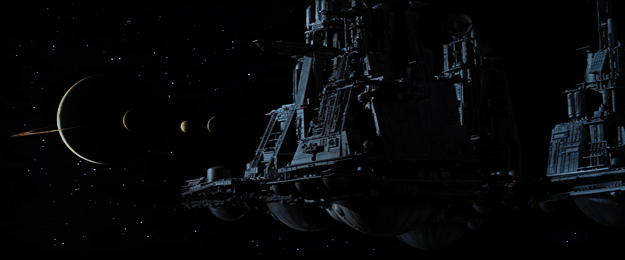
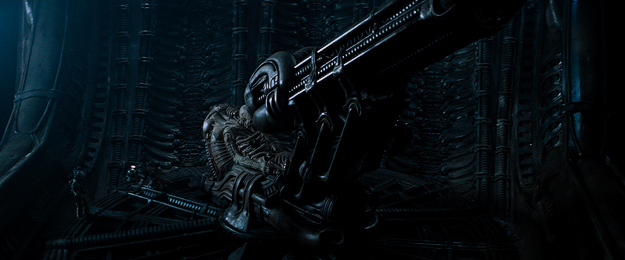
THE OPENING-DAY ENGAGEMENTS
Identified in this section of the article are the theaters in the United States and Canada in which Alien opened during its first wave launch on May 25th, 1979. Unlike a saturation launch commonplace today, Alien opened initially in only 91 theaters in 53 markets. The majority of these bookings were presented in 70-millimeter and Six-Track Dolby Stereo. This distribution and exhibition model/strategy was chosen to emphasize presentation quality and exclusivity, which in turn helped create a special event and build strong word of mouth.
(The 35mm exceptions are noted next to the applicable venues. As well, the 70mm prints were screened in some venues equipped with non-Dolby-brand audio playback equipment.)
The duration of these engagements, measured in weeks, has been included in parenthesis after each entry to provide an impression of the movie’s success.

ARIZONA
- Phoenix — Plitt’s Cine Capri (20)
ARKANSAS
- Little Rock — UA’s Cinema 150 (12)
CALIFORNIA
- Corte Madera — Marin’s Cinema (12)
- Fountain Valley — Pacific’s Fountain Valley Drive-In (11) [35mm]
- Fresno — Festival Enterprises’ Festival 6-plex (16)
- Los Angeles (Hollywood) — UA’s Egyptian Triplex (21)
- Los Angeles (Van Nuys) — Pacific’s Sepulveda Drive-In (8) [35mm]
- Los Angeles (Westwood Village) — GCC’s Avco Center Triplex (10)
- Newport Beach — Edwards’ Newport Twin (17)
- Orange — Plitt’s City Center Twin (12)
- Sacramento — Syufy’s Century 6-plex (18)
- San Diego — AMC’s Fashion Valley 4-plex (22) [35mm]
- San Francisco — Plitt’s Northpoint (17)
- San Jose — Syufy’s Century 22 Triplex (24)
COLORADO
- Denver — Commonwealth’s Cooper Twin (19)
CONNECTICUT
- East Hartford — Redstone’s Showcase 6-plex (11)
- Orange — Redstone’s Showcase 5-plex (10)
DELAWARE
- Claymont — Sameric’s Eric Tri-State Mall Triplex (12)
DISTRICT OF COLUMBIA
- Washington — Circle’s Uptown (19)
FLORIDA
- Kendall — Wometco’s Dadeland Twin (16)
- North Miami Beach — Wometco’s 163rd Street (11)
HAWAII
- Honolulu — Consolidated’s Cinerama (18)
ILLINOIS
- Calumet City — Plitt’s River Oaks 4-plex (10)
- Chicago — GCC’s Ford City Triplex (11) [35mm]
- Chicago — Plitt’s State Lake (13)
- Lombard — GCC’s Yorktown 4-plex (11) [35mm]
- Milan — Redstone’s Showcase 7-plex (12)
- Niles — Fink’s Golf Mill Triplex (10)
- Norridge — M&R’s Norridge 4-plex (10)
- Peoria — Kerasotes’ Beverly (10)
- Schaumburg — Plitt’s Woodfield 4-plex (12)
- Springfield — Kerasotes’ Esquire 4-plex (10)
INDIANA
- Fort Wayne — MSM’s Holiday Twin (9)
- Indianapolis — Y&W’s Eastwood (13)
IOWA
- Des Moines — Dubinsky’s River Hills (10)
- Dubuque — Dubuque’s Cinema Center Triplex (8)
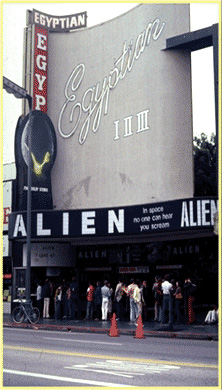 KENTUCKY
KENTUCKY
- Florence — Mid States’ Florence 6-plex (12)
- Louisville — Redstone’s Showcase 9-plex (14)
MASSACHUSETTS
- Boston — Sack’s Charles Triplex (16)
- Seekonk — Redstone’s Showcase 6-plex (11)
- West Springfield — Redstone’s Showcase 8-plex (12)
MICHIGAN
- Bloomfield — Redstone’s Showcase Pontiac 5-plex (12)
- Grosse Pointe Woods — NGT’s Woods Twin (12)
- Livonia — NGT’s Mai Kai (12)
- Southfield — NGT’s Americana 4-plex (12)
- Southgate — NGT’s Southgate Triplex (12)
- Sterling Heights — Redstone’s Showcase 7-plex (12)
MINNESOTA
- Minneapolis — Plitt’s Skyway Triplex (12)
MISSOURI
- Creve Coeur — Wehrenberg’s Creve Coeur (18)
- Kansas City — AMC’s Midland Triplex (13)
NEBRASKA
- Omaha — Commonwealth’s Indian Hills Twin (12)
NEW JERSEY
- Edison — GCC’s Menlo Park Twin (10)
- Lawrenceville — Sameric’s Eric Twin (10)
- Paramus — RKO Stanley-Warner’s Route Four 4-plex (9)
- Pennsauken — Sameric’s Eric Triplex (18)
NEW YORK
- Cheektowaga — Holiday’s Holiday 6-plex (12)
- Colonie — Mann’s Fox Colonie (9)
- DeWitt — Cinema National’s Shoppingtown Twin (11)
- New York — Loews’ New York Twin (10)
- New York — Loews’ Orpheum Twin (5)
- New York — Moss’ Criterion (19)
- Pittsford — Loews’ Pittsford Triplex (11)
- Syosset — UA’s Syosset (12)
NORTH CAROLINA
- Charlotte — Plitt’s Park Terrace Twin (16)
OHIO
- Cincinnati — Mid States’ Carousel Twin (17)
- Columbus — Mid States’ Continent 4-plex (14)
- Dayton — Chakeres’ Dayton Mall 4-plex (17)
- Toledo — Redstone’s Showcase 4-plex (10)
- Whitehall — Sugarman’s Cinema East (16)
OKLAHOMA
- Oklahoma City — Oklahoma Cinema’s North Park 4-plex (10)
ONTARIO
- Toronto — Famous Players’ University (12)
OREGON
- Beaverton — LT’s Westgate Triplex (12)
- Portland — LT’s Eastgate Triplex (12)
PENNSYLVANIA
- Fairless Hills — Sameric’s Eric Twin (10)
- King of Prussia — Sameric’s Eric King Twin (12)
- Monroeville — Redstone’s Showcase East 5-plex (10)
- Montgomeryville — Sameric’s Eric Triplex (13)
- Philadelphia — Sameric’s Eric’s Place (21)
- Pittsburgh — Cinemette’s Warner (10)
- Robinson — Redstone’s Showcase West 5-plex (9)
TEXAS
- Dallas —Plitt’s Medallion (19)
- Fort Worth — Plitt’s Ridglea (16)
- Houston — AMC’s Almeda 9-plex (16+) [35mm]
- Houston — AMC’s Northoaks 6-plex (8+) [35mm]
- Houston — AMC’s Westchase 5-plex (16+)
- Houston — Plitt’s Alabama (18)
- Richardson — Plitt’s Promenade Twin (16) [35mm]
UTAH
- Riverdale — Tullis-Hansen’s Cinedome 70 Twin (7)
- Salt Lake City — Plitt’s Centre (20)
WASHINGTON
- Seattle — UA’s Cinema 150 (24)
- Tacoma — SRO’s Tacoma Mall Twin (13)
Additional bookings of Alien commenced in June 1979 and continued to open throughout North America during summer and into autumn. (Ninety-nine percent of the presentations during this phase of the film’s release were standard 35mm.)
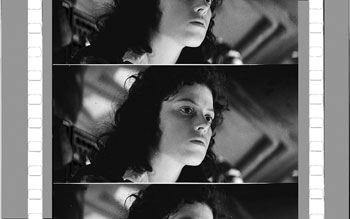
THE Q&A
Chris Barsanti is the author of The Sci-Fi Movie Guide: The Universe of Film from Alien to Zardoz (Visible Ink; 2014). Barsanti’s other books include Filmology: A Movie-a-Day Guide (Adams Media; 2010), Handy New York City Answer Book (Visible Ink; 2017), and (with Brian Cogan and Jeff Massey) Monty Python FAQ: All That’s Left to Know about Spam, Grails, Spam, Nudging, Bruces, and Spam (Applause; 2017). He is a member of the National Book Critics Circle, Online Film Critics Society and New York Film Critics Online, and has written for Film Journal International, Film Threat and The Hollywood Reporter.
J.W. Rinzler is the author of The Making of Alien (forthcoming from Titan). He was the former executive editor of LucasBooks, the publishing division of Lucasfilm Ltd., during which time he wrote several Lucasfilm-themed books including The Making of Star Wars: Revenge of the Sith (Lucas Books, 2005), The Art of Star Wars: Episode III—Revenge of the Sith (Del Rey, 2005), The Making of Star Wars (Ballantine/Del Rey, 2007), The Making of The Empire Strikes Back (Ballantine/Del Rey, 2010), The Making of Return of the Jedi (Ballantine/Del Rey, 2013), The Sounds of Star Wars (Chronicle, 2010), Star Wars: The Blueprints (47North, 2013), and (with Laurent Bouzereau) The Complete Making of Indiana Jones: The Definitive Story Behind All Four Films (Ballantine/Del Rey, 2008). Rinzler’s other books include The Making of Planet of the Apes (Harper Design, 2018) and All Up: Odyssey of the Rocketmen (CreateSpace, 2018), and he is the writer-director of the animated short Riddle of the Black Cat (2012).
Paul M. Sammon is the author of Ridley Scott: The Making of His Movies (Close-Up Series; Da Capo; 1999) and Alien: The Illustrated Screenplay (Orion; 2000). Sammon’s other books include Future Noir: The Making of Blade Runner (HarperPrism; 1996; and updated in 2007 and 2017), The Making of Starship Troopers (Berkley; 1997), Aliens: The Illustrated Screenplay (Orion; 2001) and Conan the Phenomenon (Dark Horse; 2013). He has also written for American Cinematographer, Cinefex, Empire and the Los Angeles Times.
The interviews were conducted separately and have been edited into a “roundtable” conversation format.
Michael Coate (The Digital Bits): How do you think Alien should be remembered on its 40th anniversary?
Chris Barsanti: As maybe the greatest space-set monster movie of all time. Whether or not that is significant is in the eye of the beholder.
J.W. Rinzler: Anyway they want. I remember it as a terrifying experience, seeing it in 1979.
Paul M. Sammon: Alien should be remembered on its 40th anniversary as one of the top ten most significant and influential science fiction/horror/designer cinema films of the 20th century.
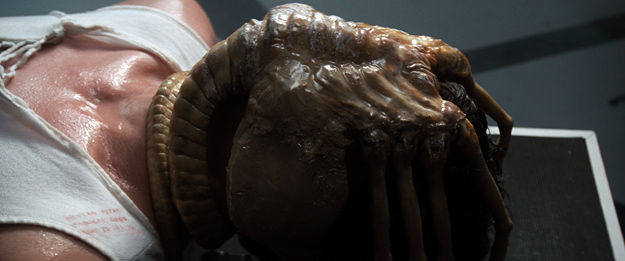
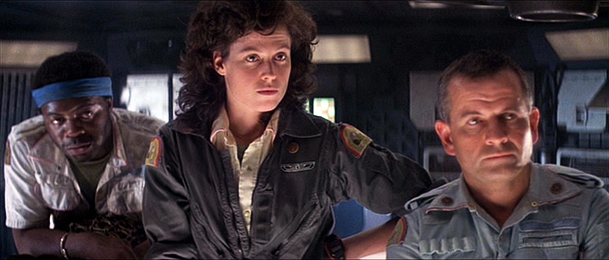
Coate: What do you remember about the first time you saw Alien?
Barsanti: I saw it on VHS at a sleepover. We ate pizza and stayed up too late. I remember that I didn’t want my friends to know how terrified I was. I remember that the room we were watching it in had a large sliding glass door and that the night outside was dark enough to hide all kind of horrible things. I do not remember sleeping.
Rinzler: I remember it as a terrifying experience.
Sammon: I initially saw Alien during the first weekend of its opening theatrical release. My wife was with me. The theater was sold out, as there was already a buzz about this picture, one which, in that pre-Internet age, was solely due to word-of-mouth. And the communal experience of seeing the film was quite extraordinary. Basically, Alien’s makers could not have asked for a better audience response.
I immediately realized within the first few minutes that I was participating in a significant pop-culture event. The crowd loved it, was totally in sync with whatever mood was up there on the screen. Suspense, eerieness, wry humor, horrified surprise, whatever. We were living it, in the moment. Like only the best motion pictures make you do.
So I certainly enjoyed myself, and was caught up in the middle of that shared emotional stew. Yet part of me remained curiously unmoved. As I told my wife when we were leaving...she asked me what I felt about what we’d just seen, and I replied, “If I was 17 years old instead of 29, I’d be doing cartwheels out of the theater.” You can make of that statement what you will.
Coate: In what way is Alien a significant motion picture?
Barsanti: It was one of three major redefinitions of science-fiction film that occurred over a period of just a few years. From Star Wars to Alien to Blade Runner, you can see the roots just about every major genre permutation that would sprout up over the following couple of decades. Like those other trailblazers, Alien broke new frontiers in special effects storytelling. Like Blade Runner (also by Ridley Scott) it parsed the potential for psychological examination in a futuristic context.
Rinzler: It solidified the idea of space as not pristine, from a design POV. From that plus Star Wars, people making movies that take place in space could be more creative in how they depicted whatever world they were exploring. Also had a very strong female protagonist in Sigourney Weaver.
Sammon: The most common response over the decades to that question has been how effectively, and in such a strikingly original way, Alien successfully melded the science fiction, monster movie and horror genres. Which is of course completely accurate. There really had not been such an impactful example of what was essentially a “haunted house in outer space” movie prior to Ridley Scott’s film. Although there had been cheaper, lesser-known ones that were pretty damn good — Mario Bava’s Planet of the Vampires being among the most well-known precursor in that subgenre.
But beyond what I’ve mentioned, what’s always struck me about Alien was not only its obsessive attention to production detail and design but the fact that Scott and an uncredited Walter Hill (who did a major rewrite on Dan O’Bannon script) were able to present the film in such a subtle, adult way. Alien wasn’t only a ground breaking mashup of science fiction and horror — it was basically a serious film, deadly serious. One that elevated what could have been 99-cent-store material to a level of sophistication and maturity previously only seen in a handful of motion pictures like 2001, Quatermass and the Pit, and Colossus The Forbin Project.
Furthermore, Alien (like other 1970s films such as Jaws, Superman, Close Encounters of the Third Kind, The Godfather, and Star Wars) was a seminal landmark in the upgrade of shopworn B-movie clichés — monsters, comic book characters, flying saucers, gangsters, Saturday afternoon serials — into major A-movie assets.
Let’s not forget that with Alien’s central, ever-mutating creature, Ridley Scott and H.R. Giger created an iconic monster that’s endured for 40 years. The Xenomorph has joined the lasting ranks of classic cinematic creatures like Dr. Frankenstein’s monster, the Wolfman, and the Creature from the Black Lagoon. The last of which recently showed up in barely disguised fashion as an amphibious lover in The Shape of Water.
Another aspect of the film that caused great interest during its initial release was Alien’s graphic sexuality. By that I do not mean sexual explicitness; I’m referring to the film’s unprecedented proliferation of elegant yet strongly suggestive phallic and vaginal symbols.
The most obvious is the Xenomorph’s head. That’s essentially a gigantic penis, equipped with an extruding, “penetrating” tongue, making it doubly phallic. As for the alien eggs, those could not be more feminine. Aggressively so, interestingly enough, since they launch facehuggers which extrude phallic tubes in order to inseminate their hosts. Another feminine motif; the vaginal openings to Giger’s derelict alien spacecraft, which still stands as one of the most brilliantly original designs ever conceived for an extraterrestrial cinematic spaceship.
What I also find fascinating 40 years on is the perverse sexuality snaking through Alien’s narrative. For example, the first person to be impregnated by a facehugger is not, as one would expect in a traditional genre offering, a woman. Instead it is a man, Kane, portrayed by John Hurt. The one man who is the Nostromo’s most curious crewmember. Kane makes the great mistake of touching the alien egg, triggers a facehugger, and is then, in essence, orally raped by the same creature.
Right there you have a fairly overt subtext. Next you have an inversion of natural human birth — it’s a man who gestates and delivers an alien creature, via the chest burster. All of Alien’s human men, in fact, except for Yaphet Kotto’s Parker, wind up becoming feminized by being inseminated by the monster. And in the Director’s Cut they’re eventually turned into eggs, too!
As for Ash, he might be a robot, but there’s a strange sexuality at work there as well. The more frustrated he becomes, the more he starts to “leak” a milky substance that’s revealed to be artificial blood. But that blood looks awfully semen-like. Which Ash sprays all over Ripley, incidentally, as he attempts to kill her by rolling up a porno mag and stuffing it down her throat. Another oral rape. Then, later, a suggested vaginal rape occurs. The tip of the Xenomorph’s barbed tail is seen inching up Lambert’s (Veronica Cartwright’s) leg. Cut to her letting out a copper-lunged scream. Ugh!
Finally, I find it very thought-provoking that the one character who displays such a strong mixture of masculine and feminine characteristics — Ripley — is the only character that the Alien does not really attack. At least, not until the end of the film, when Ripley provokes it by bombarding it with steam. I mean, why doesn’t the Xenomorph go after her the instant they’re alone in the shuttle together? I know the perceived wisdom is that the creature is either dying by that point or going dormant. Or maybe it’s just the old suspension of disbelief coming into play. But one way of looking at the full-grown creature’s curious inaction could be that it was actually confused by a human who does not exhibit traditional gender characteristics.
In any event, I find Alien’s visual and narrative “perversions,” if you will, to be fairly radical for any science fiction picture. Especially one released in 1979.
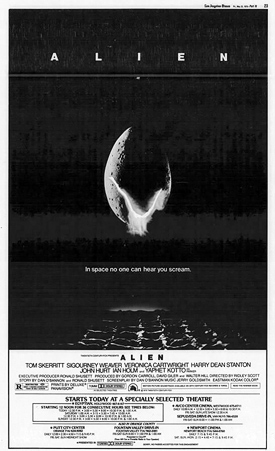 Coate: How would you describe Alien to someone who has never seen it or to someone who has avoided seeing it because they dislike science-fiction and/or horror films?
Coate: How would you describe Alien to someone who has never seen it or to someone who has avoided seeing it because they dislike science-fiction and/or horror films?
Barsanti: I would honestly tell them not to see it. It is both science fiction and horror. Somebody who doesn’t like either of those genres will not enjoy this one in any way. Similarly no matter how great I find Rio Bravo or The Magnificent Seven, if somebody doesn’t like Westerns, they should still stay away.
Rinzler: That in some ways the most interesting part of the film is before the alien manifests. The silent prowling through corridors; the exploration of the derelict; the amazing production design. The crew interaction.
Sammon: I’d say it’s not cheap. It’s not stupid. It’s not a piece of junk, or a gore picture. To use a more simplistic form of the vernacular, I’d say Alien was a really well done movie. One that’s suspenseful, scary, beautiful to look at, and involving in a way that very few films of its genre are. It has terrific characters, excellent acting, and a fantastic mood. Alien’s exceptionally atmospheric. And it’s definitely not just about spaceships flying past and shooting at each other, or about people’s heads being bitten off. Instead, it’s spooky! Suspenseful! Riveting! Truly classic! In fact, in a way, Alien is a science fiction and horror movie for people who don’t like science fiction or horror movies!
Coate: In what way was Ridley Scott an ideal choice to direct Alien and where do you think the film ranks among his body of work?
Barsanti: Scott made sense for the movie due to his dedication at this time to a dense lattice of dark visualization that made the script secondary. This is less of a story than a mood piece. And Scott was at the time a master of mood. These days, he is too impatient a filmmaker to create something like Alien.
Rinzler: Scott was an inspired “get” by the combo of Sandy Lieberson in the UK, David Giler at Brandywine, and then Alan Ladd at Fox, to take a chance. But Scott had proved himself a master in many respects with The Duellists.
Sammon: Ridley Scott has proven throughout a long and distinguished career that he is one of the most visually accomplished and genuinely artistic of our contemporary film directors. And Ridley used his many, many talents to hoist up Alien up to a height of accomplishment that very few other directors or designers of that period, circa 1979, could have achieved.
As for ranking... Ridley’s so prolific, it’s hard for me to assign a numerical value to his corpus. Alien is certainly within his top five; its influence has been lasting and ubiquitous. Right up there with Blade Runner’s.
Coate: Where do you think Alien ranks among the Alien franchise?
Barsanti: Second. To my way of thinking there is not much to be done in this franchise that wasn’t accomplished in Alien and James Cameron’s gung-ho space marine follow-up Aliens. David Fincher’s Alien 3 had potential but it was mostly squandered. After that, it was mostly just variations on people running down dark tunnels screaming.
Sammon: Obviously, number one. I know people love Aliens, the second film in the franchise. I do too. Cameron did an incredible job on Aliens. But there would have been no Aliens without Alien. Just as there would have been no Empire Strikes Back without A New Hope. Which means that I prefer the first Star Wars film over its first sequel. That sequel’s amazing, too. But again, I think the first Star Wars film is far superior to The Empire Strikes Back. A New Hope had a certain purity and innocence and energy that’s been lacking in every Star Wars film since. Even Empire. Wherein I could already detect the creeping influence of that dreaded franchise in the making attitude, the venal virus of sequel-itis.
Coate: What is the legacy of Alien?
Barsanti: The same legacy that we are seeing in just about every genre movie of note. It’s a once-memorable classic that broke new ground whose significance is now being ground into nonexistence by the filmmakers’ and studios’ refusal to just let it go and stop making sequels and spinoffs.
Sammon: Alien’s legacy is multifaceted. It proved that mainstream Hollywood could actually make a frightening, claustrophobic science-fiction movie that was also an adult, Gothic horror film with world-class production designs and a truly original monster at the center of its vicious little heart.
Alien was also a movie that audiences worldwide found involving and scary and funny and suspenseful and ultimately cathartic, in a positive way, due to a surprisingly upbeat climax. And, oh yeah: Alien was an early, powerful example of a commercial Hollywood film starring a woman who was every bit as resourceful — and ultimately more successful — than the men around her.
They all died, if you’ll recall. Only Ripley survived. She deserved to!
Coate: Thank you — Chris, Jonathan, and Paul — for sharing your thoughts about Alien on the occasion of its 40th anniversary.
--END--
IMAGES
Selected images copyright/courtesy Brandywine Productions, CBS-Fox Home Video, Dolby Laboratories, Bobby Henderson, Magnetic Home Video, 20th Century Fox Film Corporation, 20th Century Fox Home Entertainment.
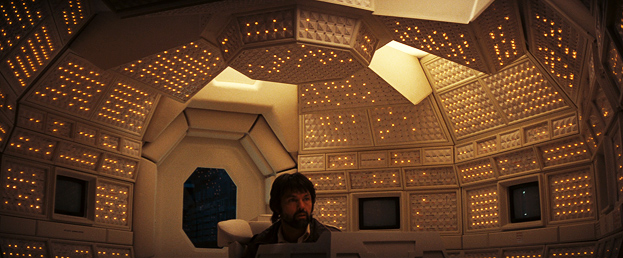
SOURCES/REFERENCES
The primary references for this project were regional newspaper coverage and trade reports published in Billboard, Boxoffice, The Hollywood Reporter, and Variety. All figures and data included in this article pertain to the United States and Canada except where stated otherwise. This work is based upon articles by same author previously published at In70mm.com and in Widescreen Review magazine.
SPECIAL THANKS
Bobby Henderson, Bill Kretzel, Mark Lensenmayer, Monty Marin, and an extra special thank-you to all of the librarians who assisted with this project.
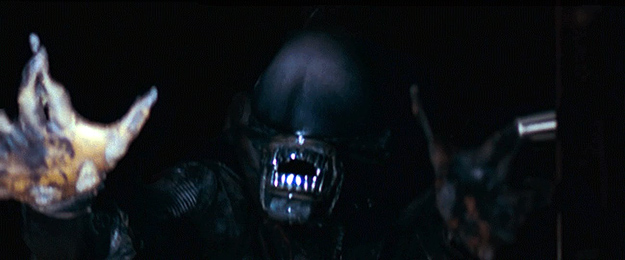
IN MEMORIAM
- Bill Rowe (Re-Recording Mixer), 1931-1992
- Bolaji Badejo (“Alien”), 1953-1992
- Denys Ayling (Director of Photography Miniature Effects), 1917-1998
- Eddie Powell (“Alien”), 1927-2000
- Mary Selway (UK Casting), 1936-2004
- Jerry Goldsmith (Music), 1929-2004
- Adrian Biddle (Focus Puller/First Assistant Camera), 1952-2005
- Gordon Carroll (Producer), 1928-2005
- Helen Horton (voice of “Mother”), 1923-2009
- Dan O’Bannon (Screenwriter), 1946-2009
- Derek Vanlint (Director of Photography), 1932-2010
- Carlo Rambaldi (Alien Head Effects), 1925-2012
- H.R. Giger (Alien Design), 1940-2014
- Peter Weatherley (Editor), 1930-2015
- John Hurt (“Kane”), 1940-2017
- Mary Goldberg (US Casting), 19??-2017
- Harry Dean Stanton (“Brett”), 1926-2017
- John Mollo (Costume Designer), 1931-2017
- Ray Merrin (Re-Recording Mixer), 1937-2018
- Michael Seymour (Production Designer), 1932-2018
- Terry Rawlings (Editor), 1933-2019
-Michael Coate
Michael Coate can be reached via e-mail through this link. (You can also follow Michael on social media at these links: Twitter and Facebook)


